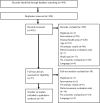Cost-effectiveness of cardiac rehabilitation: a systematic review
- PMID: 29654096
- PMCID: PMC6109236
- DOI: 10.1136/heartjnl-2017-312809
Cost-effectiveness of cardiac rehabilitation: a systematic review
Abstract
Patients may be offered cardiac rehabilitation (CR), a supervised programme often including exercises, education and psychological care, following a cardiac event, with the aim of reducing morbidity and mortality. Cost-constrained healthcare systems require information about the best use of budget and resources to maximise patient benefit. We aimed to systematically review and critically appraise economic studies of CR and its components. In January 2016, validated electronic searches of the National Health Service Economic Evaluation Database (NHS EED), Health Technology Assessment, PsycINFO, MEDLINE and Embase databases were run to identify full economic evaluations published since 2001. Two levels of screening were used and explicit inclusion criteria were applied. Prespecified data extraction and critical appraisal were performed using the NHS EED handbook and Drummond checklist. The majority of studies concluded that CR was cost-effective versus no CR (incremental cost-effectiveness ratios (ICERs) ranged from $1065 to $71 755 per quality-adjusted life-year (QALY)). Evidence for specific interventions within CR was varied; psychological intervention ranged from dominant (cost saving and more effective) to $226 128 per QALY, telehealth ranged from dominant to $588 734 per QALY and while exercise was cost-effective across all relevant studies, results were subject to uncertainty. Key drivers of cost-effectiveness were risk of subsequent events and hospitalisation, hospitalisation and intervention costs, and utilities. This systematic review of studies evaluates the cost-effectiveness of CR in the modern era, providing a fresh evidence base for policy-makers. Evidence suggests that CR is cost-effective, especially with exercise as a component. However, research is needed to determine the most cost-effective design of CR.
Keywords: cardiac rehabilitation; health care economics; systemic review.
© Article author(s) (or their employer(s) unless otherwise stated in the text of the article) 2018. All rights reserved. No commercial use is permitted unless otherwise expressly granted.
Conflict of interest statement
Competing interests: None declared.
References
-
- GBD 2015 Disease and Injury Incidence and Prevalence Collaborators. Global, regional, and national incidence, prevalence, and years lived with disability for 310 diseases and injuries, 1990-2015: a systematic analysis for the Global Burden of Disease Study 2015. Lancet 2016;388:1545–602. 10.1016/S0140-6736(16)31678-6 - DOI - PMC - PubMed
-
- British Association for Cardiovascular Prevention and Rehabilitation. The six core components for cardiovascular disease prevention and rehabilitation. 2017. http://www.bacpr.com/resources/AC6_BACPRStandards&CoreComponents2017.pdf (accessed 26 Nov 2017).
-
- British Heart Foundation. The national audit of cardiac rehabilitation annual statistical report. 2016. http://www.cardiacrehabilitation.org.uk/docs/BHF_NACR_Report_2016.pdf (accessed 7 Apr 2017).
-
- NHS England. A resource to support commissioners in setting a level of ambition on reducing premature mortality prepared by medical directorate, NHS england factsheet: increase uptake of cardiac rehabilitation for people with coronary artery disease and following acut. 2014. https://www.england.nhs.uk/wp-content/uploads/2014/02/pm-fs-3-10.pdf (accessed 22 Jul 2017).
Publication types
MeSH terms
Grants and funding
LinkOut - more resources
Full Text Sources
Other Literature Sources
Medical

